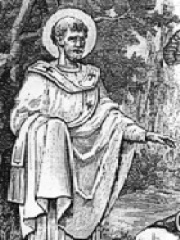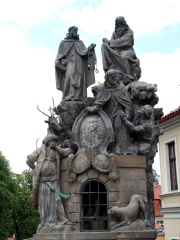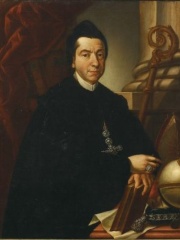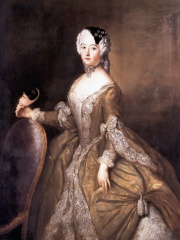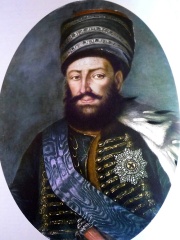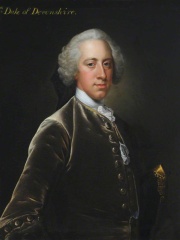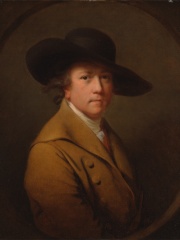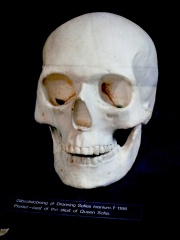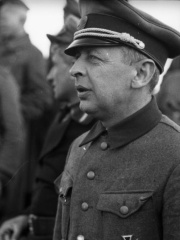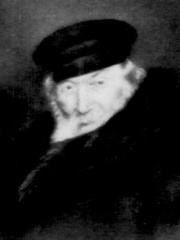RELIGIOUS FIGURE
Vilna Gaon
1720 - 1797

 Vilna Gaon
Vilna Gaon
Elijah ben Solomon Zalman, (Hebrew: ר' אליהו בן שלמה זלמן Rabbi Eliyahu ben Shlomo Zalman), also known as the Vilna Gaon (Yiddish: דער װילנער גאון Der Vilner Goen; Polish: Gaon z Wilna, Gaon Wileński; or Elijah of Vilna; Sialiec, Polish–Lithuanian Commonwealth, April 23, 1720 – Vilnius, Russian Empire, October 9, 1797), was a Lithuanian Jewish talmudist, halakhist, kabbalist, and the foremost leader of misnagdic (non-hasidic) Jewry of the past few centuries. He is commonly referred to or by his Hebrew acronym גר״א Gr״a Gaon Rabbenu Eliyahu "Our teacher Elijah the Genius", or in Modern Hebrew as ha-Gaon mi-Vilna "the genius from Vilnius". Through his annotations and emendations of Talmudic and other texts, he became one of the most familiar and influential figures in rabbinic study since the Middle Ages. Although he is chronologically one of the Acharonim, some have considered him one of the Rishonim. Read more on Wikipedia
His biography is available in 38 different languages on Wikipedia (up from 37 in 2024). Vilna Gaon is the 1,006th most popular religious figure (down from 947th in 2024), the 33rd most popular biography from Belarus (up from 38th in 2019) and the most popular Belarusian Religious Figure.
Rabbi Elijah ben Shlomo Zalman, known as the Vilna Gaon, was a famous Talmudic scholar and the leader of the Mitnagdic Jewish community in the 18th century. He is most famous for his work on the Talmud, which he would study for hours each day.
Memorability Metrics
Page views of Vilna Gaon by language
Among RELIGIOUS FIGURES
Among religious figures, Vilna Gaon ranks 1,006 out of 3,187. Before him are Sophronius of Jerusalem, Frumentius, Basil Fool for Christ, Peter Mogila, Leopold Mandić, and John of Matha. After him are Isidore of Kiev, John the Merciful, Andrea Amati, Teobaldo Boccapecci, Sebastian Castellio, and Mariano Rampolla.
Most Popular Religious Figures in Wikipedia
Go to all RankingsSophronius of Jerusalem
560 - 638
HPI: 66.98
Rank: 1,000
Frumentius
400 - 383
HPI: 66.97
Rank: 1,001
Basil Fool for Christ
1468 - 1552
HPI: 66.96
Rank: 1,002
Peter Mogila
1596 - 1647
HPI: 66.94
Rank: 1,003
Leopold Mandić
1866 - 1942
HPI: 66.93
Rank: 1,004
John of Matha
1150 - 1213
HPI: 66.89
Rank: 1,005
Vilna Gaon
1720 - 1797
HPI: 66.86
Rank: 1,006
Isidore of Kiev
1385 - 1463
HPI: 66.86
Rank: 1,007
John the Merciful
550 - 619
HPI: 66.86
Rank: 1,008
Andrea Amati
1505 - 1577
HPI: 66.84
Rank: 1,009
Teobaldo Boccapecci
1100 - 1126
HPI: 66.84
Rank: 1,010
Sebastian Castellio
1515 - 1563
HPI: 66.83
Rank: 1,011
Mariano Rampolla
1843 - 1913
HPI: 66.82
Rank: 1,012
Contemporaries
Among people born in 1720, Vilna Gaon ranks 12. Before him are Philip, Duke of Parma, Emperor Sakuramachi, Anna Maria Mozart, Louisa Ulrika of Prussia, Honoré III, Prince of Monaco, and Charles Bonnet. After him are James Hargreaves, Heraclius II of Georgia, William Cavendish, 4th Duke of Devonshire, Balaji Baji Rao, Frederick II, Landgrave of Hesse-Kassel, and Johann Schobert. Among people deceased in 1797, Vilna Gaon ranks 12. Before him are François-Noël Babeuf, James Hutton, Agha Mohammad Khan Qajar, Elisabeth Christine of Brunswick-Wolfenbüttel-Bevern, Lazare Hoche, and Frederick II Eugene, Duke of Württemberg. After him are Maria Anna Sophia of Saxony, Joseph Wright of Derby, Yves-Joseph de Kerguelen-Trémarec, Pasquale Anfossi, Wang Zhenyi, and Asaf-ud-Daula.
Others Born in 1720
Go to all RankingsPhilip, Duke of Parma
POLITICIAN
1720 - 1765
HPI: 70.91
Rank: 6
Emperor Sakuramachi
POLITICIAN
1720 - 1750
HPI: 70.59
Rank: 7
Anna Maria Mozart
COMPOSER
1720 - 1778
HPI: 69.62
Rank: 8
Louisa Ulrika of Prussia
COMPANION
1720 - 1782
HPI: 69.22
Rank: 9
Honoré III, Prince of Monaco
POLITICIAN
1720 - 1795
HPI: 67.70
Rank: 10
Charles Bonnet
BIOLOGIST
1720 - 1793
HPI: 67.32
Rank: 11
Vilna Gaon
RELIGIOUS FIGURE
1720 - 1797
HPI: 66.86
Rank: 12
James Hargreaves
INVENTOR
1720 - 1778
HPI: 66.50
Rank: 13
Heraclius II of Georgia
POLITICIAN
1720 - 1798
HPI: 66.08
Rank: 14
William Cavendish, 4th Duke of Devonshire
POLITICIAN
1720 - 1764
HPI: 64.16
Rank: 15
Balaji Baji Rao
POLITICIAN
1720 - 1761
HPI: 63.77
Rank: 16
Frederick II, Landgrave of Hesse-Kassel
POLITICIAN
1720 - 1785
HPI: 63.53
Rank: 17
Johann Schobert
COMPOSER
1720 - 1767
HPI: 62.64
Rank: 18
Others Deceased in 1797
Go to all RankingsFrançois-Noël Babeuf
JOURNALIST
1760 - 1797
HPI: 74.14
Rank: 6
James Hutton
GEOLOGIST
1726 - 1797
HPI: 71.28
Rank: 7
Agha Mohammad Khan Qajar
POLITICIAN
1742 - 1797
HPI: 69.77
Rank: 8
Elisabeth Christine of Brunswick-Wolfenbüttel-Bevern
COMPANION
1715 - 1797
HPI: 68.26
Rank: 9
Lazare Hoche
MILITARY PERSONNEL
1768 - 1797
HPI: 67.03
Rank: 10
Frederick II Eugene, Duke of Württemberg
NOBLEMAN
1732 - 1797
HPI: 66.94
Rank: 11
Vilna Gaon
RELIGIOUS FIGURE
1720 - 1797
HPI: 66.86
Rank: 12
Maria Anna Sophia of Saxony
POLITICIAN
1728 - 1797
HPI: 65.02
Rank: 13
Joseph Wright of Derby
PAINTER
1734 - 1797
HPI: 64.87
Rank: 14
Yves-Joseph de Kerguelen-Trémarec
EXPLORER
1734 - 1797
HPI: 62.93
Rank: 15
Pasquale Anfossi
COMPOSER
1727 - 1797
HPI: 62.80
Rank: 16
Wang Zhenyi
ASTRONOMER
1768 - 1797
HPI: 61.81
Rank: 17
Asaf-ud-Daula
POLITICIAN
1748 - 1797
HPI: 60.27
Rank: 18
In Belarus
Among people born in Belarus, Vilna Gaon ranks 33 out of 368. Before him are Yakub Kolas (1882), Raphael Lemkin (1900), Mstislav I of Kiev (1076), Sophia of Minsk (1140), Bronislav Kaminski (1899), and Maria Kaczyńska (1942). After him are Marek Edelman (1922), Nikolay Krestinsky (1883), Rogneda of Polotsk (966), Elena Glinskaya (1510), Bronislava Nijinska (1891), and Ivan Yakubovsky (1912).
Others born in Belarus
Go to all RankingsYakub Kolas
WRITER
1882 - 1956
HPI: 67.62
Rank: 27
Raphael Lemkin
LAWYER
1900 - 1959
HPI: 67.60
Rank: 28
Mstislav I of Kiev
POLITICIAN
1076 - 1132
HPI: 67.49
Rank: 29
Sophia of Minsk
COMPANION
1140 - 1198
HPI: 67.17
Rank: 30
Bronislav Kaminski
MILITARY PERSONNEL
1899 - 1944
HPI: 67.00
Rank: 31
Maria Kaczyńska
POLITICIAN
1942 - 2010
HPI: 66.88
Rank: 32
Vilna Gaon
RELIGIOUS FIGURE
1720 - 1797
HPI: 66.86
Rank: 33
Marek Edelman
POLITICIAN
1922 - 2009
HPI: 66.73
Rank: 34
Nikolay Krestinsky
POLITICIAN
1883 - 1938
HPI: 66.63
Rank: 35
Rogneda of Polotsk
COMPANION
966 - 1002
HPI: 66.47
Rank: 36
Elena Glinskaya
POLITICIAN
1510 - 1538
HPI: 66.27
Rank: 37
Bronislava Nijinska
DANCER
1891 - 1972
HPI: 65.97
Rank: 38
Ivan Yakubovsky
MILITARY PERSONNEL
1912 - 1976
HPI: 65.94
Rank: 39
Among RELIGIOUS FIGURES In Belarus
Among religious figures born in Belarus, Vilna Gaon ranks 1. After him are Menachem Mendel Schneersohn (1789), Michael Rohoza (1540), Kirill of Turov (1130), Chaim Kanievsky (1928), Yisrael Meir Kagan (1838), Tadevuš Kandrusievič (1946), Jakub Szynkiewicz (1884), and Detention of Pavel Pernikaŭ (null).
Vilna Gaon
1720 - 1797
HPI: 66.86
Rank: 1
Menachem Mendel Schneersohn
1789 - 1866
HPI: 59.76
Rank: 2
Michael Rohoza
1540 - 1599
HPI: 58.92
Rank: 3
Kirill of Turov
1130 - 1182
HPI: 58.16
Rank: 4
Chaim Kanievsky
1928 - 2022
HPI: 57.93
Rank: 5
Yisrael Meir Kagan
1838 - 1933
HPI: 57.52
Rank: 6
Tadevuš Kandrusievič
1946 - Present
HPI: 55.72
Rank: 7
Jakub Szynkiewicz
1884 - 1966
HPI: 55.32
Rank: 8
Detention of Pavel Pernikaŭ
HPI: 35.78
Rank: 9

